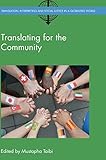Rethinking Language and Culture in Japanese Education : Beyond the Standard / ed. by Shinji Sato, Neriko Musha Doerr.
Material type: TextSeries: Multilingual MattersPublisher: Bristol ; Blue Ridge Summit : Multilingual Matters, [2014]Copyright date: ©2014Description: 1 online resource (256 p.)Content type:
TextSeries: Multilingual MattersPublisher: Bristol ; Blue Ridge Summit : Multilingual Matters, [2014]Copyright date: ©2014Description: 1 online resource (256 p.)Content type: - 9781783091843
- 9781783091850
- 306.44/0952 23
- P35.5.J3 R48 2014
- online - DeGruyter
- Issued also in print.
| Item type | Current library | Call number | URL | Status | Notes | Barcode | |
|---|---|---|---|---|---|---|---|
 eBook
eBook
|
Biblioteca "Angelicum" Pont. Univ. S.Tommaso d'Aquino Nuvola online | online - DeGruyter (Browse shelf(Opens below)) | Online access | Not for loan (Accesso limitato) | Accesso per gli utenti autorizzati / Access for authorized users | (dgr)9781783091850 |
Frontmatter -- Contents -- Contributors -- Introduction -- Part 1: Theoretical Framework -- 1. Standardization of Language and Culture -- 2. Language as a Countable and the Regime of Translation -- Part 2: Kokugo Education: Japanese Education Designed for 'Native Speakers' -- 3. On the Necessity of 'Being Understood': Rethinking the Ideology of Standardization in Japan -- 4. Rethinking 'Norms' for Japanese Women's Speech -- 5. Constructing and Constructed Japanese: The History of Standard Japanese and Practice at a Japanese Preschool -- 6. How Japanese Education for Young People Has Been Discussed: A Critical Analysis from a Relational Viewpoint -- 7. A Consideration of the Discourse on Mother Tongue Instruction in Japanese Language Education: A Case Study of the Practices of Japanese Language Classes for Chinese Returnees and Vietnamese Residents -- Part 3: Nihongo Education: Japanese Education Designed for 'Non-Native Speakers' -- 8. Teaching Japanese People's Thinking: Discourses on Thought Patterns in Post-war Studies of Japanese Language Education -- 9. On Learning Japanese Language: Critical Reading of Japanese Language Textbook -- 10. Critical Teaching of Japanese Culture -- 11. The Process of Standardization of Language and Culture in a Japanese-as-a-Foreign-Language Classroom: Analysis of Teacher-Students Interactions -- Conclusion and Departure -- Index
restricted access online access with authorization star
http://purl.org/coar/access_right/c_16ec
How does language or culture come to be standardized to the degree that it is considered 'homogeneous'? How does teaching language relate to such standardization processes? How can teaching be mindful of the standardization processes that potentially involve power relations? Focusing on the case of Japanese, which is often viewed as homogenous in terms of language and culture, this volume explores these questions in a wide range of contexts: the notions of translation and modernity, the ideologies of the standardization of regional dialects in Japan, current practices in college Japanese-as-a- Foreign-Language classrooms in the United States, discourses in journals of Japanese language education, and classroom practices in nursery and primary schools in Japan. This volume's investigation of standardization processes of Japanese language and culture addresses the intersections of theoretical and practical concerns of researchers and educators that are often overlooked.
Issued also in print.
Mode of access: Internet via World Wide Web.
In English.
Description based on online resource; title from PDF title page (publisher's Web site, viewed 24. Apr 2022)


